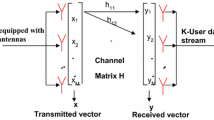Abstract
Currently, multiple input multiple output (MIMO) systems are adopted in many current cellular systems such as Long Term Evolution or 802.16 m. However, the performance of MIMO systems is greatly dependent on system parameters and environments. In this study, we evaluate the performance of downlink MIMO systems to find out which operating frequency among 800 MHz, 2.5 GHz, and 3.5 GHz is the best for next generation MIMO cellular systems. For each operating frequency, we consider the most prevalent types of mobile stations (MSs), the USB type, PDA type, and laptop type, which experience different mutual coupling between neighbor antenna elements mainly caused by the miniaturization of MSs. System simulation results show that regardless of the MS type, average and edge throughputs are almost the same for all the considered frequencies in the interference-limited environment. In contrast, the operating frequency of 800 MHz at which the mobile type with a larger antenna spacing has spatial multiplexing gain, provides the best average and edge throughputs in noise limited system environments.
Similar content being viewed by others
References
M. F. Abedin, and M. Ali, Reducing the mutual-coupling between the elements of a printed dipole array using planar EBG structures, in Proceedings of Antennas and Propagation Society International Symposium, Vol. 2A, pp. 598–601, July 2005.
S. M. Alamouti, A simple transmit diversity technique for wireless communications, IEEE Journal on Select Areas in Communications, Vol. 16, No. 8, pp.1451–1458, Oct 1998.
X. Artiga, B. Devillers, and J. Perruisseau-Carrier, Mutual coupling effects in multi-user massive MIMO base stations, in Proceedings on Antennas and Propagation, Society International Symposium (APSURSI),July 2012.
D. S. Baum, J. Hansen, G. Del Galdo, M. Milojevic, J. Salo, and P. Kyosti, An interim channel model for beyond-3G systems: extending the 3GPP spatial channel model (SCM), in Proceedings of VTC ’05, vol. 5, pp. 3132–3136, Stockholm, Sweden, May–June 2005.
D. W. Browne, M. Manteghi, M. P. Fitz, and Y. Rahmat-Samii, Experiments with compact antenna arrays for MIMO radio communications, IEEE Transactions on Antenna and Propagation, Vol. 54, No. 11, pp.812–822, Nov 2006.
S. H. Chae, S. Oh, and S. Park, Analysis of mutual coupling, correlations, and TARC in WiBro MIMO array antenna, IEEE Antennas and Wireless Propagation Letters, Vol. 6, pp.122–125, June, 2007.
G. J. Foschini, and M. J. Gans, On limits of wireless communications in a fading environment using multiple antennas, Wireless Personal Communication, Vol. 6, No. 3, pp. 311–355, Mar 1998.
3GPP TR 25.996, 3rd Generation Partnership Project; Technical Specification Group Radio Access Network; Spatial channel model for Multiple Input Multiple Output (MIMO) simulations, V8.0.0, 2008.
I. J. Gupta, and A. K. Ksienski, Effect of mutual coupling on the performance of adaptive arrays, IEEE Transactions on Antenna and Propagation, Vol. 31, No. 5, pp. 785–791, Sept 1983.
R. W. Heath, T. Wu, and A. C. K. Soong, MIMO spatial mode adaptation at the cell edge using interferer spatial correlation, in Proceedings of IEEE VTC Spring, Barcelona, Apr 2009.
<online>http://ecen665web.groups.et.byu.net/notes/ln2.pdf, Antennas and Propagation for Wireless Communications
J. Jiang, M. F. Demirkol, and M. A. Ingram, Measured capacities at 5.8 GHz of indoor MIMO systems with MIMO interference, in Proceedings of IEEE VTC Fall, Orlando, Oct 2003.
A. Khaleghi, A. Azoulay, and J. C. Bolomey, Dual band diversity antenna system for mobile phones, in Proceedings of Wireless Communication Systems, pp. 351–355, Sept 2005.
J. S. Kwak, J. G. Andrews, and A. Lozano, MIMO capacity in correlated interference-limited channels, in Proceedings of ISIT07, Nice, France, June 2007.
B. Lindmark, Capacity of a 2 x 2 MIMO antenna system with mutual coupling losses, in Proceedings of IEEE Antennas and Propagation Society International Symposium Digital, pp. 1720–1723, 2004.
A. C. K. Mak, C. R. Rowell, and R. D. Murch, Isolation enhancement between two closely packed antennas, IEEE Transactions on Antenna and Propagation, Vol. 56, No. 11, pp. 3411–3419, Nov. 2008.
P. Minard, J.-F. Pintos, and A. Louzir, Compact USB stick with integrated antenna diversity for digital terrestrial TV reception, in Proceedings of AP-S, pp. 4741–4744, June 2007.
A. L. Moustakas, S. H. Simon, and A. M. Sengupta, MIMO capacity through correlated channels in the presence of correlated interfers and noise: a (not so) large N analysis, IEEE Transactions on Information Theory, Vol. 49, No. 10, pp. 1−17, Oct 2003.
NGMN Alliance, “Next Generation Mobile Networks Radio Access Performance Evaluation Methodology,” NGMN, Jan. 2008.
F. Rusek, D. Persson, D. B. K. Lau, E. G. Larsson, T. L. Marzetta, O. Edfors, and F. Tufvesson, Scaling up MIMO: opportunities and challenges with very large arrays, Signal Processing Magazine, Vol, 30, pp. 40–60, Jan 2013.
T. Savantesson, and A. Ranheim, Mutual coupling effects on the capacity of multielement antenna systems, in Proceedings of IEEE ICASSP 2001, Salt Lake City, USA, pp. 2485–2488, 2001.
A. Sulima, K.S. Han, V. Rakytyanskyy, and J.W. Kim, A modified printed inverted-F antenna for mobile communications, in Proceedings of AP-S, pp. 1–4, July 2008.
D. Yue, and Q. Wang, Analysis of MIMO systems in the presence of co-channel interference and spatial correlation, theory and applications, InTech, 2011.
Acknowledgments
This research is supported by Basic Science Research Program through the National Research Foundation of Korea (NRF) funded by the Ministry of Education, Science and Technology (2012-0003878), and SK Telecom.
Author information
Authors and Affiliations
Corresponding author
Rights and permissions
About this article
Cite this article
Yang, J. On the Performance of Downlink MIMO Systems with Different Operating Frequencies. Int J Wireless Inf Networks 20, 229–234 (2013). https://doi.org/10.1007/s10776-013-0209-5
Received:
Accepted:
Published:
Issue Date:
DOI: https://doi.org/10.1007/s10776-013-0209-5




